Emerging 1300- and 1550-nm devices minimize dispersion and loss in standard optical fiber for long-distance telecom applications.
Nadya Anscombe, Contributing Editor
Vertical-cavity surface-emitting lasers (VCSELs) are now routinely used in photonics applications such as telecommunications, primarily at 850 nm. Their long-wavelength cousins — 1300- and 1550-nm devices — still have some way to go before they achieve such success.
For many years, analysts have predicted that long-wavelength VCSELs will become the laser source of choice for most telecom and datacom (including 10 Gigabit Ethernet) applications. Loss in standard optical fiber is lowest at 1550 nm, and dispersion is lowest at 1300 nm. Both of these factors facilitate long-distance transmission across optical fibers.
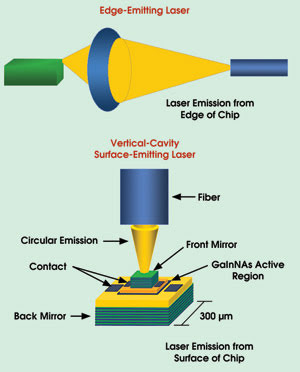
Unlike conventional semiconductor lasers, which emit from the side, VCSELs emit from the surface, which allows on-wafer testing arrays of devices. The beam profile emitted also facilitates coupling with optical fibers.
But producing long-wavelength VCSELs is tough, primarily because of the challenge of growing an optimal combination of a good-quality active region and high-reflectivity mirrors. Many companies, young and old, have tried to bring a product to market and failed (see table for a sampling). Others are coming up with innovative designs and solutions to the manufacturing challenges, but many of these are some time away from a commercial product.
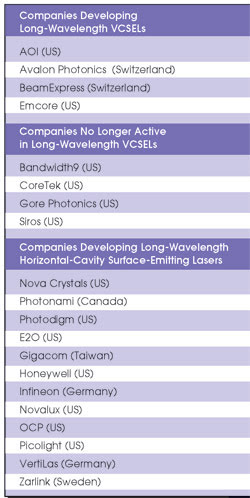 Long-wavelength VCSELs have a lot of catching up to do. Edge emitters such as Fabry-Perot lasers and distributed feedback lasers are firmly established in the market and have much higher power outputs. And because the laser itself is only a small part of the cost of a transceiver (5 to 10 percent), long-wavelength VCSELs still must be significantly cheaper than edge emitters to stand a chance on the market. Parity with edge emitters in cost alone will not drive market infiltration.
Long-wavelength VCSELs have a lot of catching up to do. Edge emitters such as Fabry-Perot lasers and distributed feedback lasers are firmly established in the market and have much higher power outputs. And because the laser itself is only a small part of the cost of a transceiver (5 to 10 percent), long-wavelength VCSELs still must be significantly cheaper than edge emitters to stand a chance on the market. Parity with edge emitters in cost alone will not drive market infiltration.
Material matters
Two material systems are battling it out for a share of this potentially lucrative market: nitrides and indium phosphides. The obvious choice would be to use InGaAsP, the same material system that has proved reliable for Fabry-Perot and distributed feedback lasers; however, this presents difficulties because of the limited range of refractive index values available to form suitable distributed Bragg reflectors. For example, to achieve the same reflectivity achievable with 30 mirror pairs of AlGaAs/AlAs (a common material family in the active region for short-wavelength VCSELS) at least 50 to 60 mirror pairs of materials in the InGaAsP system would be required.
InGaAsN materials also have their challenges. This is the newest material to be considered for VCSEL applications and is therefore not as well-understood as InGaAsP. It is, however, one of the few material systems to combine both long-wavelength emission (up to 1300 nm) with monolithic growth compatibility with GaAs substrates and the established GaAs/AlGaAs mirror technology. Also, no group has so far reported 1550-nm devices based on a nitride material system.
Although growing high-quality InGaAsN for long-wavelength VCSELs is difficult, the resulting devices reportedly perform well at high temperatures — beneficial because mirror-related temperature issues in general remain one of the main problems facing manufacturers of these lasers.
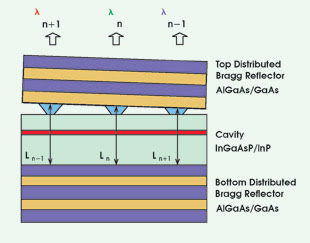
This monolithic array emits at three wavelengths in the 1550-nm band. It shows a specially designed active cavity material made of InP/InGaAsP with three mesas of different heights. The wafer fusion of the top and bottom AlGaAs/GaAs distributed Bragg reflectors is performed in the same way as for single-wavelength devices.
So when will these challenges be overcome, and when will more long-wavelength VCSELs infiltrate the market?
VCSEL manufacturers are optimistic, of course. Some have announced availability of product already, and others predict volume quantities in the next 12 months. Tom Hausken, director of optical communications components at Strategies Unlimited in Mountain View, Calif., is not so confident. Although he agrees that the technology has many potential advantages and presents an elegant solution to the needs of the photonics industry, he believes that VCSEL manufacturers will have to carry huge losses to match the price of established edge-emitting devices. He qualifies this by saying that a breakthrough in both price and performance could drive demand for long-wavelength VCSEL-based transceivers so that they make up a large share of what could become a nearly $600 million long-range transceiver market by 2007.
Nevertheless, Hausken said he feels that companies will need to act quickly to take advantage of this opportunity. “The window is small,” he explained, “but not shut.”
Dave Kisker, director of device development at Optical Communication Products in Broomfield, Colo., is more encouraged. He believes that, because Fabry-Perot and distributed feedback lasers are established technologies, VCSELs will first become the key technology for high-density applications such as parallel interconnects and multichannel modules, which are basically optical transmitter modules that contain more than one laser.
“The cost advantages of VCSELs should quickly allow them to penetrate the single-channel markets currently dominated by edge-emitting devices,” Kisker said. “In 850-nm devices, the transition took about two years. For long-wavelength devices, it will be slower, but the trend will be the same.”
The company acquired long-wavelength VCSEL technology when it bought the portfolio of Cielo Communications Inc., also of Broomfield, in October 2002. Cielo worked with Sandia National Laboratories and announced what it claimed was the first VCSEL on GaAs using the InGaAsN active layer material in May 2000. Since then, Optical Communications has demonstrated clear-eye diagrams at modulation speeds up to 10 Gb/s. “However, the first products will be at lower speeds, up to 2.5 Gb/s,” Kisker said.
He claimed that his is the only company to have published reliability data for 1.3-μm VCSELs. “Our demonstrated mean time to failure is over 15 million hours at the normal operating condition and 40 °C. In addition, we have demonstrated 5000 hours of exposure to damp heat, another key aspect of telecom laser reliability.”
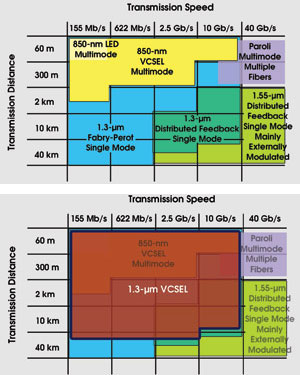
Although 1310-nm VCSELs are still in their relative infancy compared with other devices, Infineon engineers are optimistic about their potential to capture market share, as indicated by these graphs.
One of the company’s largest competitors is Honeywell International Inc. in Morristown, N.J., which is also a leading supplier of VCSELs. However, Honeywell does not yet have a long-wavelength product. Its 1310- and 1550-nm devices are still in development. According to Jim Tatum, strategic marketing manager, the devices will be on the market in 2004: “We have built a large infrastructure for automated high-volume manufacturing capability for 850-nm VCSELs that is also applicable to the long-wavelength product portfolio.” Honeywell has already demonstrated devices with 10-Gb/s modulation speeds, less than 2-mA threshold and 1 mW of output.
Infineon Technologies in Munich, Germany, however, claims to be some way ahead of both of these companies — at least on a manufacturing basis. It reported in March that it was the first to manufacture 1310-nm VCSELs in high volumes. Its products are based on the GaInNAs/GaAs material system, because it claims this enables a monolithic AlGaAs/GaAs VCSEL technology with excellent mirror quality.
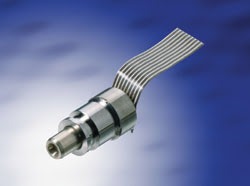
German company Infineon has claimed to be the first to manufacture 1310-nm VCSELs in high volumes.
Strictly speaking, GaInNAs/GaAs and AlGaAs/GaAs are different material systems. Still, they are both compatible with GaAs systems in terms of similar lattice constants. Because of this, it is possible to grow layers of GaInNAs and AlGaAs on top of GaAs without causing the material to physically crack from excess strain.
Kai Siemer, program manager at Infineon, said: “Among the industrial players developing long-wavelength technology, Infineon has the advantage of having both MBE [molecular beam epitaxy] and MOVPE [metall-organic vapor phase epitaxy] processes in development.” He added that the firm can manufacture VCSELs with either process, with the final decision depending on performance, yield, reliability and volume.
The company’s devices have achieved up to 3 mW of output and up to 10-Gb/s modulations, but the first products will be for 2.5-Gb/s applications. Siemer reported that products are targeted at both the datacom and telecom markets, but he believes that the datacom markets might have higher acceptance for VCSEL technology because 850-nm VCSELs have been standard for many years. “But performance as well as reliability will allow us to address telecom markets,” he said.
Marlin Semiconductor in Jarfuls, Sweden, also targets both the datacom and telecom markets with its long-wavelength devices. It first focused on materials based on GaAs substrates and published results using Gainsay quantum wells, but it is now concentrating on InGaAs quantum wells. The reason is that this material reportedly has shown excellent results and is very similar to the established GaAs VCSEL technology, with the associated advantages in manufacturability.
Europe has some interesting start-ups active in this field. An example is VertiLas GmbH in Garching, Germany, which spun off from Walter Schottky Institute of the Technical University of Munich in late 2001. Developing VCSELs in the range of 1400 to 2050 nm, it targets gas sensing and spectroscopy applications, as well as telecom. The company uses an InGaAlAs/InP material system. It reportedly has solved problems with excess heat generation through a structure that combines optimized heat sinking using a highly reflective hybrid metal/dielectric mirror with good thermal conductance. It has a buried tunnel junction to enable low-resistive lateral current confinement and waveguiding.
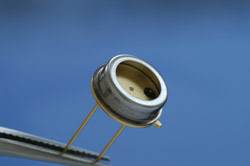
German start-up company VertiLas is developing VCSELs in the 1400- to 2050-nm range and is aiming at gas sensing and spectroscopy applications, as well as telecom.
The company reports that commercial quantities of its long-wavelength VCSELs are already available. It has achieved 10-Gb/s modulation at 20 °C and transmission distances of up to 20 km depending on the modulation speed. The threshold current of VertiLas’ lasers is 0.4 to 1 mA and the output power varies from 1 mW (single mode) to 7 mW (multimode) at 20 °C.
Another relative newcomer to the market is BeamExpress Inc. in Lausanne, Switzerland, a spin-off from the Swiss Federal Institute of Technology, also in Lausanne. It is concentrating on 1550-nm devices and has developed a proprietary fabrication process called localized wafer fusion. This, claims the company, allows the production of the best possible combination of AlGaAs/GaAs distributed Bragg reflectors and InP-based active cavity material.
This work has achieved what some consider fairly impressive results. Transmission experiments were performed at room temperature over 50 km of standard single-mode optical fiber, with results including a cleareye diagram and 10–9 bit error rate at 2.5 Gb/s.
The company is still in its research phase, and all of its results so far have been based on optically pumped devices. CEO Jean-Claude Charlier is confident that electrically pumped devices will be developed soon.
“Last year we demonstrated an optically pumped fixed-wavelength VCSEL at 1550 nm with 3-mW single-mode optical output at room temperature and more than 1 mW at 70 °C,” Charlier said. “This is the best result published in the literature so far. BeamExpress is now using a similar type of VCSEL structure to develop an electrically pumped VCSEL with all necessary modifications as described in our US patent application.”
Beyond skepticism
BeamExpress and VertiLas are not the only start-ups in this market. In fact, the majority of the companies developing long-wavelength VCSELs are start-ups based in either Europe or the US, with very little activity in Asia. Some analysts believe that this is because Asian companies have decided that VCSELs will never make it to market.
Because analysts and Asian companies seem skeptical and VCSEL manufacturers remain optimistic, the truth must lie somewhere in the middle. Infineon’s Siemer summarizes the issue well: “The long-wavelength VCSEL has the potential to replace different laser technologies, like Fabry-Perot and distributed feedback lasers, in a wide range of applications. Over the next three to five years, the VCSEL will have a significant share in these applications. But there will be applications that will continue using edge emitters, especially when it comes to high output power requirements.”
The Best of Both Worlds?
Aside from good beam-to-fiber coupling capability, an advantage of the VCSEL structure is that it emits from its surface, making testing and packaging easier. The conventional edge emitters have many other benefits, such as high power, good stability, low threshold current, simple manufacturing techniques and well-characterized material systems. So what if the output from an edge-emitting laser could be manipulated to emit from the top?
This is exactly what three companies — Photonami Inc. of Richmond Hill, Ontario, Canada, Photodigm Inc. in Richardson, Texas, and Nova Crystals Inc. in San Jose, Calif. — are doing. They are developing in-plane lasers that operate as surface-emitting devices, with the goal of combining the power and stability of an edge emitter with the surface-emitting properties of a VCSEL.
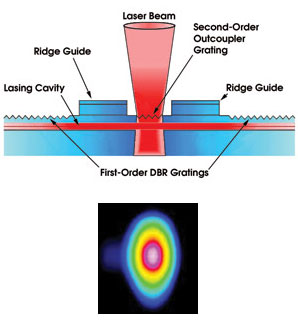
Photodigm’s grating-coupled surface-emitting laser has a horizontal cavity but emits light from its surface. Elliptical shape of the laser’s far-field beam can make fiber coupling a little more complex than if the beam were circular. (DBR: distributed Bragg grating.)
Jack Mattis, vice president of business development at Photodigm, believes that his company’s grating-coupled surface-emitting laser has advantages over both VCSELs and edge emitters and that it may well become the standard way in which edge emitters are manufactured. “Compared with edge emitters, our laser allows wafer-level testing, has a narrow beam divergence and needs fewer manufacturing steps,” he said.
The company’s product is still in the development stage, but Mattis expects small quantities to be available in the first quarter of 2004, with volume shipments a few months later. The initial product emits at 1310 nm and is electrically pumped. The company has achieved a modulation speed in excess of 2.5 Gb/s and a transmission distance of 10 km over single-mode fiber. “Reliability is not expected to be a problem,” he said, “because unlike VCSELs, we are using a proven AlInGaAs materials system.”
Mike Liwak, director of product management at Photonami, uses similar arguments when promoting its products, which use InP/ InGaAsP, another proven material system. The company’s surface-emitting distributed feedback lasers, which emit from 1270 to 1610 nm, can be tuned thermally or as part of an array. Full-packaged devices available as of June operate at up to 2.5 Gb/s and have a threshold current of less than 10 mA at 25 °C.
Liwak claimed that, in cooled applications at 25 °C, the laser has transmitted 300 km over standard single-mode fiber. He said devices will be available shortly with a reach of more than 400 km and with less than a 2-dB power penalty.
“Our surface-emitting distributed feedback spectral properties are superior to edge-emitting distributed feedbacks and do not have characteristics like a Fabry-Perot laser. Fabry-Perot behavior can result from small reflections resulting from the mirror techniques used to bring the beam out the surface,” Liwak said. “Since our design does not use a mirror to surface emit, it does not have the same issues as other horizontal-cavity surface-emitting laser techniques.”
Photonami is sampling prototypes and is in the process of transitioning to high-volume production readiness, which will be completed by the end of this year, according to Liwak. While its surface-emitting distributed feedback laser reduces costs because of on-wafer testing, the main savings come during packaging. Packaging costs dominate the overall laser module cost, particularly as the application is more demanding (higher data rates, longer reaches).
“This is where the side-emitting distributed feedback laser enables the greatest cost savings,” he said. “This laser technology removes the need for a bulk isolator, bulk lensing, a discrete power monitor and all of the associated manufacturing alignment and assembly. This reduces costs and improves package densities significantly.”
In general, the advantages of long-wavelength VCSELs over edge emitters include easier packaging because they emit from the surface, a high-quality beam, low threshold and operating currents, and lower heat dissipation.
Advantages of horizontal-cavity surface-emitting lasers over long-wavelength VCSELs include use of a proven material system, higher power output and lower turn-on voltage. The devices can also use readily available epiwafers.
There are also some reported disadvantages to horizontal-cavity surface-emitting lasers. If Fabry-Perot-based, they have multiple longitudinal modes that limit performance over distance. Devices also can have typical threshold current vs. temperature dependence. In addition, the beam shape is normally elliptical instead of circular, which complicates the packaging.
The processing to form the reflectors can also be fairly complex. Distributed-feedback-based lasers, for instance, require reflectors as well as gratings, making processing more complicated. They also are not as easily fabricated as arrays.
Whether the drawbacks of these horizontal-cavity surface-emitting lasers threaten their market success remains to be seen. Could they really be the best of both worlds?